Anemia is lack of iron in the blood. Anemia is especially dangerous for pregnant women because blood is lost during birth. This can make the anemia so severe the woman can die.
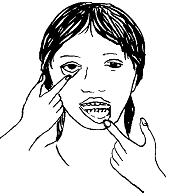
Signs of anemia
If a woman has signs of anemia she should eat foods with a lot of iron. Or she can take 300 mg of ferrous sulfate (or enough to provide 60 mg iron), 2 times a day until the baby is born. If she takes iron tablets with fruit, her body will use the iron better.

If a baby is sideways near the end of the pregnancy, make a plan for the mother to give birth in a hospital. A baby lying sideways cannot be born without an operation.
If labor has already started and the baby is sideways, take the mother to a hospital to save her and her baby's life.
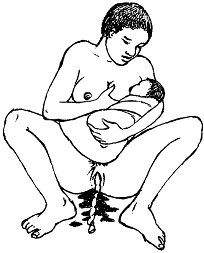
It is normal for a woman to bleed a little after birth. But treat immediately for bleeding if she:
Even if you do not see a lot of blood, watch for these signs: feeling faint, pale skin, feeling like she lost too much blood.
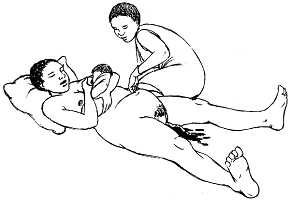
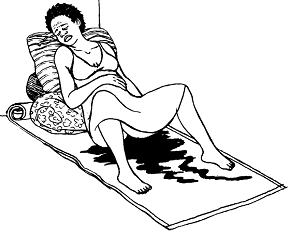
Some light, pink-colored fluid, or mucus and brown blood during labor is normal. But if the mother is bleeding bright red blood, it could mean that the placenta is separating from the womb wall or is covering the opening of the womb.

Healthy signs:
Warning signs: There is a lot of blood. Where is the woman in her pregnancy?
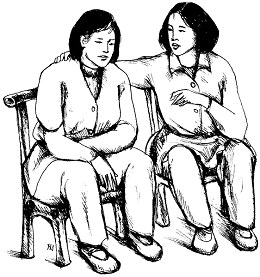
When a woman bleeds about the same as having her monthly bleeding, it is probably a miscarriage (losing the pregnancy). This is not normally dangerous to the physical health of the mother. But watch for danger signs like too much bleeding, or signs of infection such as fever, feeling faint, or a bad smell from the vagina.
Women who have had miscarriages or abortions may feel afraid, sad, or upset. This emotional pain is just as important as the pain women have in their bodies.

Bleeding during the second half of pregnancy could mean the placenta is in the wrong place or has detached from the womb. Both are serious problems.
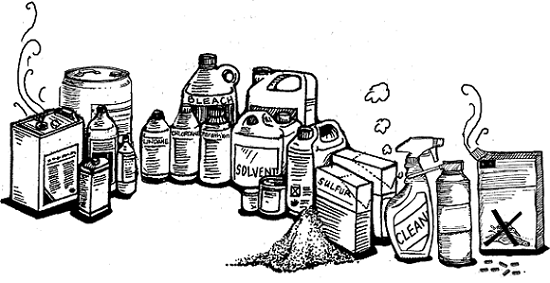
Chemicals used for cleaning and to kill pests are very dangerous to pregnant women. A pregnant woman should avoid getting chemicals on her skin or breathing their fumes. Chemical containers should never be used to carry or store food or water.
Chemicals can cause:
Poisonous chemicals are found in:
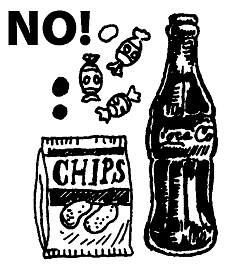
A food craving is a strong desire to eat a certain food, or even something that is not food at all, like dirt, chalk, or clay. If a woman gets a craving for nutritious foods (like beans, eggs, fruits, and vegetables), it is OK for her to eat as much as she wants.
A woman who wants a lot of "junk food" (like candy, soda, or packaged snacks) should eat nutritious food first.
A woman who craves things that are not food, like dirt or clay, should not eat them. They may poison her and her baby, or make her sick. This may be a sign that she needs more protein and iron-rich foods in her diet.
A woman who eats well is much more likely to have a healthy pregnancy and healthy baby.
Pregnant women need to eat more than usual. The extra food gives them enough energy and strength, and helps their babies grow.
Pregnant women should eat a variety of foods, some foods from each of these 3 groups every day:
| Carbohydrates: such as rice, maize, wheat, millet, cassava, taro, or plantains. |  |
| Proteins: such as beans, peas, lentils, eggs, nuts and seeds, cheese, milk, yogurt, meat, fish, or insects. | 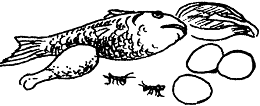 |
| Fruits and vegetables: such as leafy greens, carrots, cabbage, peppers, oranges, melons, pineapples, ripe papayas, or mangoes. | 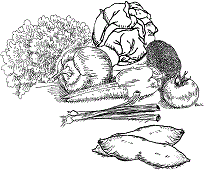 |
If a woman is not getting enough to eat, encourage her family, neighbors, and friends to share with her. Perhaps they can help tend her garden, bring her eggs from their chickens, or cook a bit extra to bring to her.
Iron and folic
acid: A pregnant woman also needs to get enough
iron to prevent anemia, and folic acid to prevent birth
defects in her baby. She should take supplements of
these to make sure she gets enough. Each day she should
take 400 to 500 mcg folic acid, and
300 mg ferrous sulfate (60 mg iron), until the baby is
born.
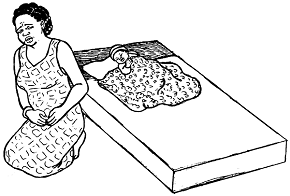
If the mother has a fever during the first weeks after the birth, she may have an infection of the womb. Other signs of womb infection are:
Give antibiotics on the way to the hospital.
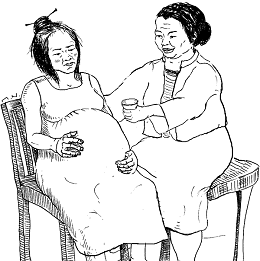
It can be normal for a woman to get warm in labor. This may be because she is dehydrated. Give rehydration drink.
A fever above 38°C (100.4°F) is usually a sign of infection. Give antibiotics on the way to the hospital.
If a woman has a fever during pregnancy, it could be caused by malaria, a sickness like flu, a kidney infection, or dehydration. Find the cause of the fever and treat it.

Along with the fever does she also:
Along with treating the cause, a high fever needs to be lowered right away.

Pregnant women are especially at risk for anemia (weak blood). Eating more foods with iron will help prevent and treat anemia. Foods with a lot of iron include:
Green or brown waters mean that the baby has passed stool inside the womb. He may be in trouble. The stool can get in the baby's mouth and nose, and it can be hard for him to get enough air.
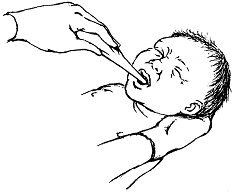
If the mother is already pushing and the birth is coming soon, be ready to clean the baby's mouth at birth. As soon as the baby's head is born, wipe his mouth and nose with a clean cloth or use a suction bulb to suck the mucus out. Keep the baby's head lower than his body to help the mucus come out. If the baby has difficulty breathing, or his skin stays blue after a few minutes, take him to a hospital.
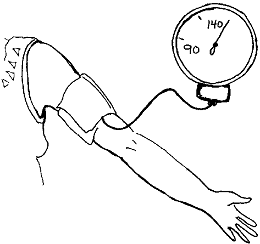
Check the mother's blood pressure at each visit during pregnancy. Write it down so you can look for changes over time.
Healthy sign: Blood pressure stays between 90/60 and 140/90 and does not go up much during pregnancy.
Warning sign: High blood pressure. The woman has high blood pressure if the top number is over 140 or the bottom number is over 90.
This can be a sign of pre-eclampsia which is a dangerous disease of late pregnancy.
If her blood pressure is very high (160/110) she has severe pre-eclampsia and needs medical help right away.

Healthy sign: If the woman's temperature is close to 37°C (98.6°F). She does not feel hot to touch.
Warning sign: Woman has fever - a temperature of 38°C (100.4°F) or above. She feels hot to touch.
If a woman has a fever during pregnancy, it could be caused by malaria, a sickness like flu, a kidney infection, or dehydration. Find the cause of the fever and treat it.

Along with the fever does she also:
Along with treating the cause, a high fever needs to be lowered right away.
During the last month of pregnancy, it may be possible for a pregnant woman to change the baby's position by lying in this position for 10 minutes, 2 times a day:

Lie on the floor with pillows under the hips. Try to get the hips higher than the head. Do this every day with an empty stomach, until the baby changes to a head-down position. Then stop.

Protein in the urine is a sign of pre-eclampsia.
There are 2 methods to check for protein
in urine.
Method 1: Use small plastic strips called Uristicks, Albusticks, or Labsticks to check for protein.
You may be able to get a bottle of these sticks from the local health authority or pharmacy. The strips have different color squares that turn from yellow to dark green. Ask the mother to urinate on the stick, and then compare the color of the squares with the color chart on the bottle.
If the square turns dark green, there is protein in the urine. This is the most accurate way to check for protein.
Method 2:
Heat the mother's urine to check
for protein.
Ask the mother to wash her genitals well and then urinate into a clean container. Then pour the urine into a test tube to within 2 centimeters (or one inch) of the top of the tube.
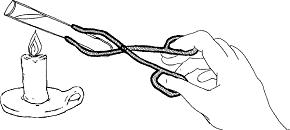 Heat the upper part
of the tube over a small burner, low flame, or candle
until the urine boils. (Keep turning the test tube or
the glass will break.)
Heat the upper part
of the tube over a small burner, low flame, or candle
until the urine boils. (Keep turning the test tube or
the glass will break.)
If the urine is clear, there is no protein in it. If the urine becomes cloudy and white, add a few drops of vinegar (2% acetic acid). If the cloudiness goes away, there is no protein in the urine. If it stays cloudy or gets whiter, there is protein in the urine.
If the woman has protein in her urine and high blood pressure, she has pre-eclampsia. When a woman has severe pre-eclampsia, the urine may become very cloudy, white, and thick.

Firmly grasp the top of the womb, and gently move it back and forth.
The baby's bottom is soft and wide. When you move it from side to side, the whole body moves with it.
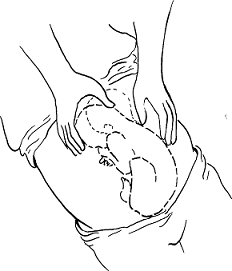
The baby's head is harder and smaller. When you move the head, the neck bends, and the body does not move much.
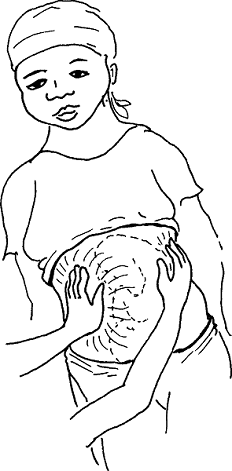
Push firmly against one side of the belly. With the other hand, feel up and down along the other side of the belly. What do you feel?
The back feels firm. The arms and legs feel like small parts and may move away when you push on them.
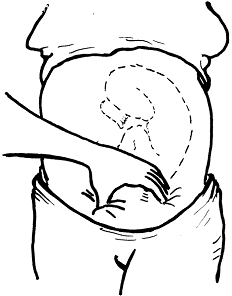
Ask the mother to slowly blow out. As she is blowing, press deeply into each side of the lower belly, just above the pubic bone.
The head feels hard. Toward the end of pregnancy it "drops" into the pelvis. If the bottom is down, it will feel softer and wider.

If the baby is breech (butt down) at the time of birth, problems are more likely. This baby should be born with the help of an experienced midwife or in a hospital.

If the baby is sideways, you can feel it's head and bottom on each side of the belly. If the baby is sideways at the time of birth, it must be born by surgery in a hospital.
A drink of castor oil and fruit juice can sometimes start or strengthen labor. If castor oil is going to help start a labor, it should work within 4 hours.
Castor oil causes stomach cramps and diarrhea (watery stool). Sometimes it also causes vomiting. Having diarrhea during labor increases the chance of infection because a little stool can easily get into the vagina. The contractions together with stomach cramps can make labor feel too fast or overwhelming for the woman.
Always warn women that castor oil tastes very bad and will make them feel very uncomfortable. Remind them to wipe from front to back after passing stool.
To use castor oil
Mix about 60 ml (2 oz) of castor oil in a cup (240 ml or 8 oz) of fruit juice. Lemon or orange juice work especially well to help with the bad flavor. Do not give more than 1 glass. The mother should drink the whole glass down.

Magnesium sulfate is used to stop seizures. This medicine can save a woman's life, but only use it on the way to a hospital or medical center.
Only use magnesium sulfate if her blood pressure is over 160/110 or if she is having a seizure. Magnesium sulfate can cause the woman to have trouble breathing, especially if she is given too much. Get medical help immediately if her breathing slows to less than 12 breaths a minute or if she has not urinated for 4 hours.
Oxytocin
Inject 10 units of oxytocin in the side of the thigh
muscle.
Misoprostol
Dissolve 800 mcg inside the mouth, against the cheek or
under the tongue, for about 30 minutes. Then swallow
what is left. If she feels nauseous, you can insert
tablets into the woman's rectum instead. Wear a
glove.
Ergometrine (only
give after the placenta has come out)
Inject 0.2 mg ergometrine in the side of the thigh
muscle.
OR, give 0.2 mg of ergometrine pills by mouth. You can
give ergometrine every 2 to 4 hours for severe
bleeding, or every 6 to 12 hours for less severe
bleeding. But continue to give the medicine until
bleeding has stopped and the womb is hard, usually
about 48 hours. Pills do not work as quickly as
injections. Do not give
ergometrine to a woman with high blood
pressure.

You will need:

What to do:



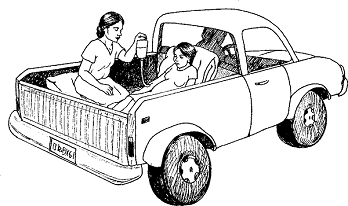
If a woman is bleeding heavily, send 2 family members with her to the hospital to give blood if needed.
If she is in shock, treat her for shock while transporting her to the hospital. If you know how, start an intravenous drip (IV). Or give rectal fluids.

What form of medicine do you have?
Choose where to inject
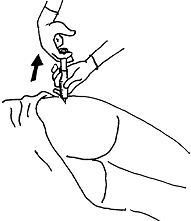 8. Pull the
plunger of the syringe out just a little. If any
blood comes into the syringe you have gone into a
vein. Take the needle out and try again.
8. Pull the
plunger of the syringe out just a little. If any
blood comes into the syringe you have gone into a
vein. Take the needle out and try again.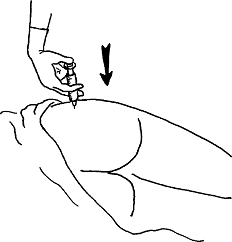 9. If no blood
enters the syringe, slowly but steadily push the
plunger in to inject the medicine into the muscle.
9. If no blood
enters the syringe, slowly but steadily push the
plunger in to inject the medicine into the muscle.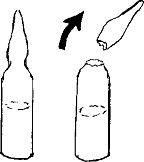
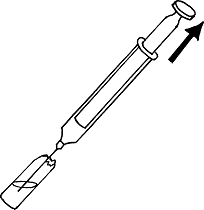 Put the needle
into the ampule. Be careful the needle does not
touch the outside of the ampule. Hold the barrel of
the syringe steady and pull the plunger - this will
draw the medicine into the syringe.
Put the needle
into the ampule. Be careful the needle does not
touch the outside of the ampule. Hold the barrel of
the syringe steady and pull the plunger - this will
draw the medicine into the syringe.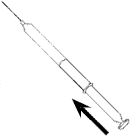 Hold the syringe
with the needle pointing up. Gently tap the barrel
of the syringe until all the air bubbles rise to
the top. Then push the plunger in just a little to
get the air out.
Hold the syringe
with the needle pointing up. Gently tap the barrel
of the syringe until all the air bubbles rise to
the top. Then push the plunger in just a little to
get the air out.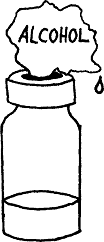
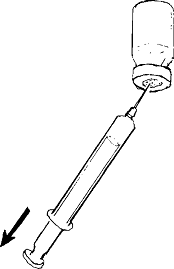 3. Turn the bottle
upside down. Be sure the tip of the needle points into
the medicine inside the bottle and not into the air.
Hold the barrel of the syringe still and slowly pull
the plunger until the correct amount of medicine enters
the syringe. Pull the syringe out of the bottle.
3. Turn the bottle
upside down. Be sure the tip of the needle points into
the medicine inside the bottle and not into the air.
Hold the barrel of the syringe still and slowly pull
the plunger until the correct amount of medicine enters
the syringe. Pull the syringe out of the bottle.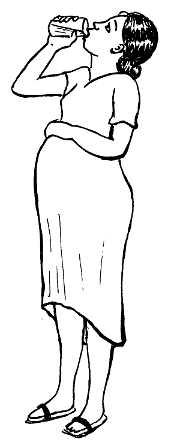
Lowering a fever will help a woman feel better, but it will not treat the cause of the fever, such as infection or malaria.
Lower a fever by giving 500 to 1,000 mg paracetamol by mouth every 4 to 6 hours (but do not give more than 4000 mg paracetamol in one day). Do not give ibuprofen to a pregnant woman in the last 3 months of pregnancy. It is not safe.
Give a sponge bath with cool (not cold) water, or use cool cloths to help bring the fever down.
Help the woman drink rehydration drink or 1 cup of water every hour. If she is too sick to drink, start an intravenous drip (IV) if you know how, or give rectal fluids.
If possible, use a 0.5% solution of bleach (chlorine) for disinfecting tools. If you do not have 0.5% bleach solution, you can make your own by mixing bleach and water:
Soaking your tools in bleach solution for 20 minutes before you clean them will help protect you from infection.
There are 2 ways of making rehydration drink. Both are good to give to any woman in labor, especially if she has a fever or has been in labor for a long time. If you can, add half a cup of fruit juice, coconut water, or mashed ripe banana to either drink. These contain potassium, a mineral which helps a sick person accept more food and drink.
Give the person sips of this drink every 5 minutes, day and night, until she begins to urinate normally. A large person needs 3 or more liters a day. Keep giving the drink often, and in small sips. Even if she vomits, not all of the drink will be vomited.
Method 1:
Drink made with powdered cereal and salt
(Powdered rice is best. But you can use finely ground maize, wheat flour, sorghum, or cooked and mashed potatoes.)

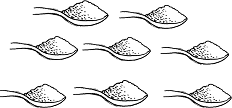
Caution: Taste the drink each time before you give it to make sure that it is less salty than tears and that it has not spoiled. Cereal drinks can spoil within a few hours in hot weather.
Method 2: Drink made with sugar and salt


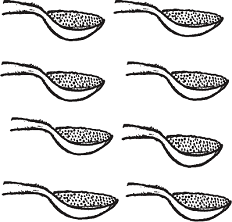
(You can use raw, brown sugar or molasses instead of white sugar)
Mix well.
Caution: Before adding the sugar, taste the drink and be sure that it is less salty than tears.

Malaria is spread by mosquitoes. To prevent malaria, avoid mosquito bites.
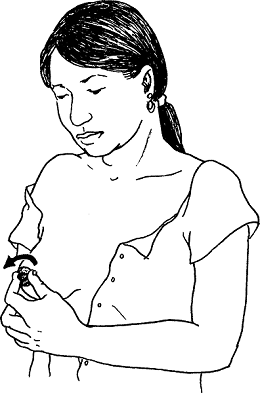
Rolling, squeezing, and massaging the nipples can help a woman have stronger contractions and start labor. Keep squeezing and massaging until her contractions get strong. If her contractions do not get stronger within half an hour, rolling the nipples probably will not help.
Rolling the nipples can also help the womb contract and stop bleeding.
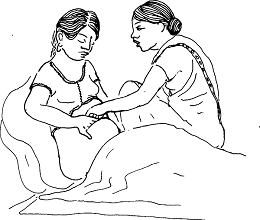
Put your hand on top of the womb and squeeze while you move the same hand in a circle. Rub the womb until it feels like a hard round ball. The womb should be in the center of the belly, not off to the left or right. If it is not in the center, have the woman urinate. Check the womb every 1 or 2 minutes for a while. If it gets soft again, rub it until it contracts again.
Rubbing the womb will be painful for the mother. You must keep rubbing to stop the bleeding, even if she is in pain.

First suction the mouth and throat until they are clear of mucus. Then suction the nose. (Practice using the syringe to suck up water before you use it at birth).
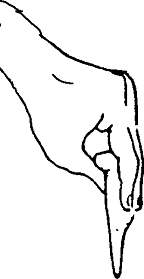
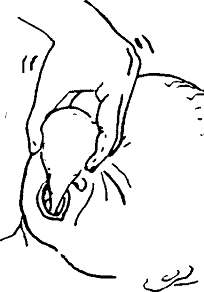

2. Close the valve on the rubber bulb by turning the screw to the right. The screw will get shorter.
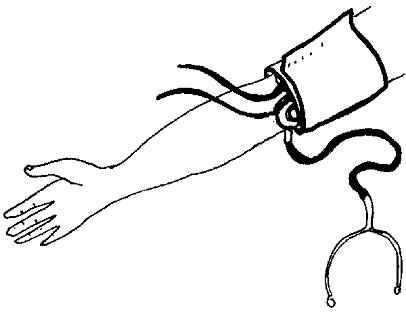
3. Feel for a pulse just below the cuff, on the inside of the elbow. Put the stethoscope over the pulse and put the ear pieces in your ear.

4. Pump up the cuff by squeezing the bulb.
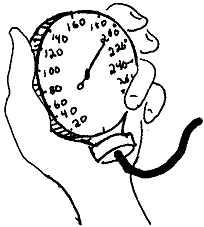
5. As you pump, the needle will move. When it reaches 200 stop pumping.
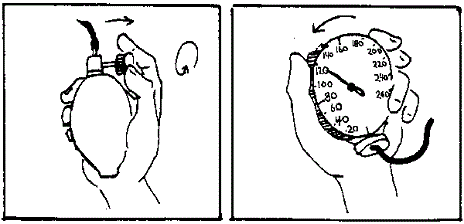
6. Then open the valve just a little so that the air leaks out slowly. As the air leaks out, you will start to hear the mother's pulse through your stethoscope.
Notice where the needle or mercury is:
(Using a thermometer marked in degrees Celsius - °C)

Clean the thermometer well with soap and cold water, or alcohol. Hold it at the end without the silver (or red) and shake it hard, with a snap of the wrist, until it reads less than 36 degrees.

Put the thermometer:
under the tongue (keep the mouth closed around it)
 OR in
the armpit if there is danger that the person might
bite the thermometer.
OR in
the armpit if there is danger that the person might
bite the thermometer.
Leave it there for 3 or 4 minutes.
Read the temperature on the thermometer. You may need to rotate the thermometer to see where the silver line stops.
Wash the thermometer well with soap and cold water. Then, if you can, soak it for 20 minutes in a bleach solution and rinse with clean water.
For mild fever during labor, ampicillin plus gentamicin will usually work. For high fever in labor, or for signs of infection after birth, use metronidazole as well to fight all the possible bacteria that can cause the infection. It is best to inject at least the first dose of ampicillin, but if you have only pills give those instead.
Ampicillin: inject 2 grams. Wait 6 hours, then inject or give by mouth 1 gram every 6 hours. AND
Gentamicin: inject 5 mg per kg, once a day. If you cannot weigh the woman, inject 80 mg, 3 times a day. AND
Metronidazole: give 500 mg by mouth, 3 times a day.
Give all 3 medicines until 2 days after signs of infection have stopped.
In case of allergy to penicillins, give 500 mg erythromycin 4 times a day instead of ampicillin. Other combinations of antibiotics can be given if they are all you have. Choose a combination that fights a wide-range of bacteria.
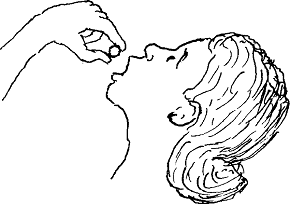
If a pregnant woman is sick with malaria, she should be treated right away.
Malaria should usually be treated with an Artemesinin-based Combination Therapy (ACT). Check with your local health authority to find out which ACT works best in your area.
If you do not know which works best, give artemether plus lumefantrine. This usually comes as a combined pill. Give 4 pills by mouth 2 times a day for 3 days. The woman should take the medicine right away after opening the package because it can lose strength once outside the package.
If the woman is in the first 3 months of pregnancy, she should take quinine plus clindamycin instead, if possible. Give 600 mg quinine 3 times a day for 7 days, AND 300 mg clindamycin 4 times a day for 7 days.
Yeast infections are common during pregnancy. They are not dangerous, but should be treated before birth.
Signs: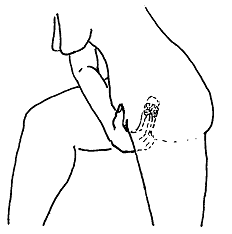 Mix 3 tablespoons
of vinegar with 1 liter boiled and cooled water.
Soak a piece of clean cotton in the mixture and
insert it into the vagina every night for 3 nights.
Remove the cotton each morning. OR
Mix 3 tablespoons
of vinegar with 1 liter boiled and cooled water.
Soak a piece of clean cotton in the mixture and
insert it into the vagina every night for 3 nights.
Remove the cotton each morning. ORIf the woman has a bladder infection, she should drink 1 glass of liquid every hour while she is awake to help wash the infection out of her body. Cranberry juice, cornsilk tea, or other home remedies often work.
If she does not start to improve quickly, or if she has any signs of a kidney infection, give antibiotics.
Antibiotics for
bladder and kidney infection:
Give 500 mg amoxicillin by mouth 3 times a day for 7
days. If she is allergic to amoxicillin or penicillin
give 960 mg cotrimoxazole by mouth 2 times a day for 7
days. But do not give cotrimoxazole in the last 3
months of pregnancy.
Prevention:
 Wipe from front to
back after urinating or passing stool to keep germs
away from the pee hole. Remind women's partners to
clean their hands and genitals before sex. Women should
also urinate right after having sex.
Wipe from front to
back after urinating or passing stool to keep germs
away from the pee hole. Remind women's partners to
clean their hands and genitals before sex. Women should
also urinate right after having sex.
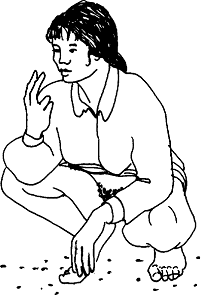
Discharge is the wetness all women have from the vagina. Pregnant women often have a lot of discharge, especially near the end of pregnancy. It may be clear or yellowish. This is normal.
If the discharge is white and lumpy, and if the vagina itches, this might be a yeast infection.
Discharge with a very bad smell, or heavy discharge with pain in the belly, can be a sign of a sexually transmitted infection. She should see a health worker.
This app is a collaboration between Hesperian and UnaMesa.

Hesperian Health Guides is a non-profit publisher of books, newsletters and online resources for community-based health care.
Visit Hesperian for more great resources.

The UnaMesa Association is a public charity dedicated to improving healthcare, education, and social services through innovations in technology and tools for sharing knowledge.
Learn more at www.unamesa.org
Content: All rights reserved, copyright Hesperian Health Guides. Please contact [email protected] for more information.
Application
source code: available on
github under MIT
license.
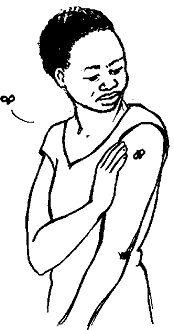
Malaria is an infection of the blood that causes chills and fever, and is spread by mosquito bites. Malaria is especially dangerous for pregnant women and their babies. A pregnant woman with malaria is more likely to have anemia, miscarriage, early birth, small baby, stillbirth (baby born dead), or to die.

Many women have nausea in the first months of pregnancy. No one knows for sure what causes this, but for many women, the way they eat affects it. If the nausea is mild, encourage the woman to try any of these remedies:
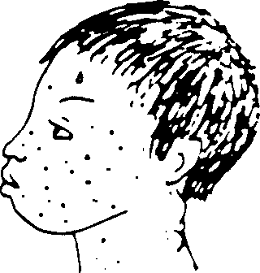
A pregnant woman should avoid sick people to prevent getting sick herself. Some sicknesses are particularly dangerous to pregnant women or their babies. Rubella (German measles) is one sickness that can cause serious birth defects in the baby, including deafness and heart problems. It can even cause death.
There is a vaccine to prevent Rubella. A woman should not get this vaccine while she is pregnant, but her family and children should. A community-wide vaccination program is the best protection for all women.

Pre-eclampsia is when a woman has:
Pre-eclampsia can cause premature birth, bleeding, seizures, or even death for the mother.
If she only has high blood pressure, check it once a week to see if it goes up, and watch for signs of severe pre-eclampsia.
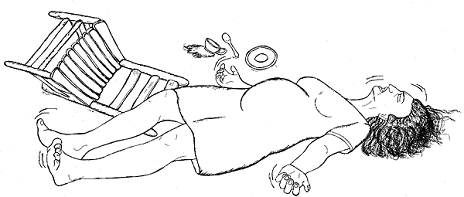
When a woman has a seizure, she may have some or all of these signs:
A seizure may last anywhere from a few seconds to many minutes.

Get medical help as soon as possible when the seizure is over.

Severe pain in the belly with or without bleeding may mean that the placenta has become separated from the wall of the womb.
Other signs that the placenta is separting from the womb are:
Watch the woman for signs of shock and start IV fluids if you know how.
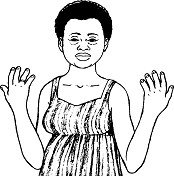
Signs of severe pre-eclampsia are:
Shock is a life-threatening condition that can result from heavy bleeding. Bleeding inside the body can also cause shock.
Signs:
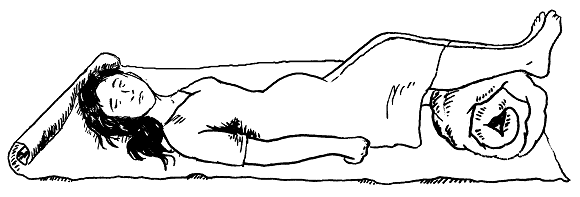
If she is unconscious, do not give her anything by mouth - no medicines, drink, or food until she has been awake for one hour.
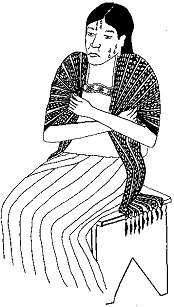
High fever, especially along with shivering, body aches, and severe headache, can be caused by malaria. Malaria is especially dangerous for pregnant women and their babies. The typical malaria attack has 3 stages:
Malaria attacks usually happen every 2 or 3 days, but they can also happen every day or only once in a while.
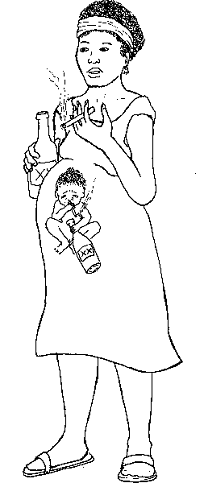
Cigarette smoke, alcohol, and other drugs are all harmful to the mother. When a woman smokes, drinks, or takes drugs, they also pass through her blood to her baby. This causes babies to be born small or dead, or can cause permanent damage to the baby's brain and body.
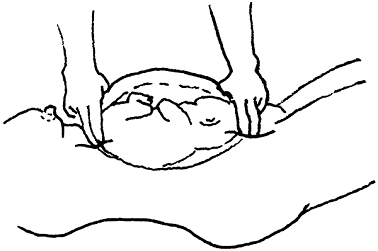
Healthy sign: The baby is head down at the time of birth.
Warning sign: The baby is breech (feet or bottom down) at the time of birth. A breech birth can have serious problems. If possible, a breech baby should be born at a well-equipped medical center, especially for a mother's first baby.
During pregnancy, it is common for a baby to change position several times in the womb. By the end of the pregnancy, the baby should be head down in the womb. This is the safest position for birth. To make sure the baby is head down, check the baby's position.
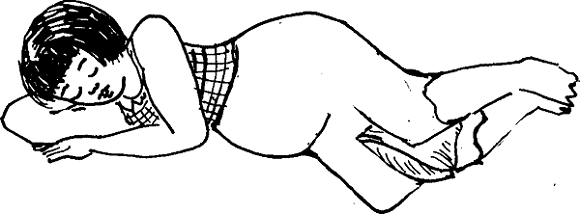
Some pregnant women feel tired much of the day. This is most common during the first 3 months.
It is normal for pregnant women to feel tired. Their bodies are telling them to slow down and rest. A woman should rest when she can. But if she also feels weak, she may have other problems, like a sickness, depression, or anemia.

A very long labor can lead to lasting health problems for the mother, or may be a sign that the baby cannot come out without medical help. Labor is too long when:
If her contractions are not coming every 2 to 3 minutes, or if she can still talk through them, she is not in active labor yet. Encourage her to sleep. If she cannot sleep, have her walk, dance, climb stairs or hills. Help her to drink and eat light foods.
Once contractions are coming regularly and are strong, be mindful of the time. Also think about how far from help you are, in case it is needed. You may need to try to strengthen her labor at home or get medical help.
Medicines a pregnant woman takes also pass to her baby. And some medicines that are safe for an adult, can cause birth defects or other harm to the baby. So pregnant women should avoid most medicines. For minor problems like headaches, stomach aches, and colds, rest and fluids are better treatment than medicines.
But some illnesses are too harmful to leave untreated throughout pregnancy. Always treat for malaria, bladder or kidney infections, HIV or AIDS, and sexually transmitted infections.
Ask an experienced health worker if you are not sure if a particular medicine is safe in pregnancy and during breastfeeding.
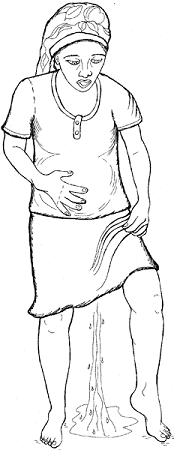
Most women will give birth within 24 hours after their waters break. If labor has not started within 12 hours, the woman and her baby could get a serious infection.
The mother must not put anything in her vagina. This could cause an infection.
Try to strenghten labor. If labor does not start after a few more hours, she should go to a health center or hospital.
If she has a fever or there is a bad smell in the vagina, an infection is starting. Give antibiotics on the way to the hospital.
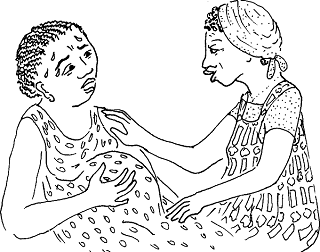
First, check the baby's position to make sure he is not sideways.